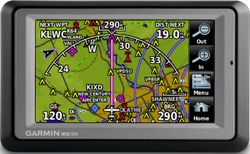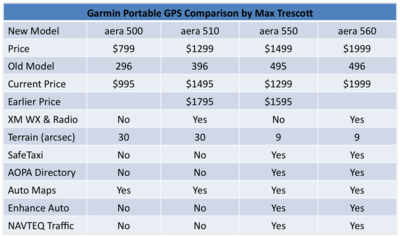 Garmin’s announcement today of four new portable
Garmin’s announcement today of four new portable
GPS products—the aera 500, 510, 550 and 560—essentially refreshes all but the
high end of their portable aviation GPS product line. To help pilots understand
these products, I’ve put together a comparison chart that compares the aera GPS
with the Garmin…
296, 396, 495 and 496 units that they will eventually replace.
These new products don’t affect the high end of the portable product line, the
Garmin 695 and 696, however retailers are offering a $300 rebate on those units
until the end of the year. Those units will be of interest to pilots who want
to display electronic instrument approach charts, a capability not available on
the aera GPS units.
All of the aera GPS units feature touch screen
capability while lowering most of the price points of the products they
replace. Users can also switch between aviation and automotive functions with a
single touch screen key, a major improvement over older units. For pilots
interested in receiving XM Satellite weather—a service that any serious pilot
should have in the cockpit—the new aera line significantly lowers the cost of
getting an XM-capable GPS.
I haven’t held one of the new aera GPS units yet,
but expect to later this week at AOPA Aviation Summit 2009 in Tampa, Florida.
Thus all of my observations are based upon Garmin’s press release and web site.
I’ll plan to update this story after I’ve had some time to use one of the
units.
All of the units share the same physical case. The
aera displays are about 27% larger than those of the units they replace. The
new screens measure 3.8” wide by 2.25” high versus 3.2” wide by 2.1” high. All
of the product differences are implemented using different versions of software
in each unit. Each unit comes with two mounting kits, one for airplanes and one
for automobiles.
The entry-level unit, the aera 500 lists for $799,
giving Garmin a product with a price point close to the Bendix/King AV8OR,
which also features a touch screen. The primary differences among the other units are
whether they offer XM Weather or include the AOPA Directory and SafeTaxi
diagrams. I am a huge fan of XM weather and pilots can now get this capability
with the aera 510 for $1299 plus the cost of an XM subscription. Previous, the
lowest cost Garmin GPS with XM-capability was the 396 that previously sold for
$1795 and can now be had for $1495. [Click Garmin area Portable GPS Comparison Chart to enlarge]
 The aera 550 and 560 add the AOPA Directory and
The aera 550 and 560 add the AOPA Directory and
SafeTaxi diagrams. The AOPA Directory is a great resource, however it’s also
available for free in you have an iPhone, iPodTouch or Blackberry. SafeTaxi is
a wonderful feature, particularly if you frequent larger airports with which
you’re unfamiliar. It assists a pilot while taxiing by displaying a map of
labeled runways and taxiways for 950 of the largest airports.
As you can see from my comparison chart, the price
points of the new Garmin aera GPSs are equal to or lower than the older GPS
units with one exception, the Garmin 550, which lists for $1499, $200 more than
you need to pay to get a Garmin 495. My data suggests that the Garmin 495 was
never a huge seller; most people who considered the 495 bought the 496 instead.
Thus this pricing may help clear out any old stock of Garmin 495 units,
representing a short-term bargain for pilots who don’t need XM weather yet want
the AOPA Directory or more likely the SafeTaxi diagrams.
If you’ve held off upgrading an older GPS or you
don’t yet own an aviation GPS, consider getting a Garmin aera. Since I feel
that any pilot who flies in anything other than severe clear weather should
have XM weather available in the cockpit, give strong consideration to the aera
510 and 560. Or for a low cost backup unit, consider the aera 500.